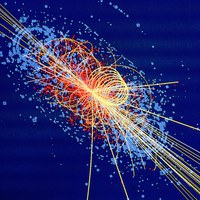keywords:
SiPM, Cherenkov detector, Electron-Ion Collider, Particle Identification Methods, Photosensor
keywords:
High-energy physics, Future circular collider, IDEA detector concept, KEY4HEP, Simulation
keywords:
LHC, high-energy physics, heavy-ion collisions
keywords:
Experimental Subnuclear Physics, Quark Gluon Plasma, Quantum Chromo Dynamics, Serches beyond the Standard Model,
keywords:
Multi-Energy monochromatic beams Radiology, X and gamma radiation Detectors, X-ray Linear Absorption Coefficient,
keywords:
LHC, CMS, Trigger systems, Muon detection and tracking, BSM, PNRR CN HPC / ICSC, SND@LHC
keywords:
Nuclear and subnuclear physics, Quantum chromodynamics, Quark-gluon plasma, High-energy heavy-ion physics, ALICE
keywords:
High Energy Physics, CMS, LHC, Software, Computing, WLCG, Grids, Clouds, Artificial Intelligence, Machine/Deep
keywords:
Quark, Elementary Particle Physics, LHCb, CERN, LHC, INFN, CP Violation
Junior assistant professor (fixed-term)
keywords:
Deep Learning; Computer Vision; Quantum Machine Learning
PhD Student
Teaching tutor
keywords:
CMS, Heavy Neutral Leptons, Machine Learning, Displaced muons
keywords:
p-p interactions, particle detectors, LHC, CMS
keywords:
gravitational waves, artificial intelligence, signal processing
keywords:
Heavy flavor production, GRID computing, Search of supersimmetries, Search of Higgs boson
Junior assistant professor (fixed-term)
keywords:
high energy physics, CMS, machine learning, artificial intelligence, Cloud solutions, data analysis, ICSC: Spoke 2,
PhD Student
Teaching tutor
keywords:
Nuclear Physics, Cross sections, FOOT, Nuclear fragmentation
Research fellow
Teaching tutor
keywords:
Large Hadron Collider - LHC, high energy phisics, phisics with accelerators, luminosity measurement, elementary
keywords:
High Energy Physics, CMS, Muons, PNRR CentroNazionale HPC
keywords:
CERN, CMS, High Energy Physics, Next-gen triggering systems, Software and computing
Senior assistant professor (fixed-term)
keywords:
CERN, LHCb, Flavor physics, Beauty and charm quarks, High energy physics, Cabibbo-Kobayashi-Maskawa (CKM) matrix
keywords:
Hypernuclei, Nuclear parity violation, In-medium chiral dynamics, Exotic nuclei structure, Nuclear mean field model,
keywords:
Higgs, top quark, BSM, Kalman Filter, hadrontherapy, FOOT, space radioprotection, Quantum Computing, Quantum Annealing,
keywords:
Firmware Design, Trigger ans Data Acquisition (ATLAS TDAQ), Networking, High Energy Physics Exeperiments HEPE,
keywords:
Distriduted computing, Experimental trigger, Control systems, Unitarity triangle, Computational grid, CP symmetry
keywords:
higgs, lhc, cms, trigger, muons
PhD Student
Teaching tutor
keywords:
Nuclear Physics, Subnuclear Physics, Radiation detectors, Software development, Imaging techniques
keywords:
Silicon Photomultiplier, Astroparticle physics, SiPM, ZEUS, AMS-02, Neutrino
keywords:
Data Science and Computation, Networking, ATLAS experiment, TDAQ
keywords:
(anti)nuclei, helium, ALICE, coalescence, dark matter, pp, high-energy physics, quark-gluon plasma
keywords:
astrophysical neutrinos, high energy cosmic rays, elementary article physics, Monte Carlo simulations,
keywords:
Nuclear Astrophysics, s process, Neutron physics, Cross section measurements, Emerging nuclear technology
keywords:
Neutrino physics, neutrino oscillations, DUNE, Astroparticle Physics and Cosmology, Euclid
PhD Student
Teaching tutor
keywords:
neutrino physics at LHC, SND@LHC, CMS drift tubes
keywords:
Particle Physics
PhD Student
Teaching tutor
keywords:
n_TOF, Nuclear Data Evaluation
keywords:
Particle Physics
keywords:
Computing, CMS, Data analysis, CERN, Parameter tuning, Machine learning
keywords:
particle detector, muons, metabolic radiotherapy, imaging, neutrino, scintillator, hyperthermia, Moodle, E-Learning,
keywords:
Silicon detectors, High Energy Physics detectors, Timing performance, Nuclear Physics, ALICE
keywords:
Experimental nuclear and subnuclear Physics, Quark Gluon Plasma (QGP), Particle Detectors
keywords:
particle physics, meson spectroscopy, quantum mechanics, standard model
keywords:
High Energy Physics, Beyond Standard Model Physics, Collider Physics, Neutrino mass models
keywords:
Computing in High Energy Physics, CMS, LHC, High Energy Physics, Particle detectors, Computer and network security,
keywords:
Multimessenger aspects of neutrino astrophysics, Particle physics
keywords:
Nuclear and Subnuclear Physics, Quark-Gluon Plasma, ALICE Experiment, Silicon sensors, Particle detectors,
PhD Student
Teaching tutor
keywords:
FOOT, nuclear fragmentation, data analysis, tracking reconstruction, MC simulations
keywords:
ATLAS, Luminosity, Data acquisition systems, Hadrontherapy
keywords:
heavy flavour, Luminosity, Hadrotherapy, particle physics, Space radioprotection, Nuclear and subnuclear physics, Higgs
keywords:
BSM, Collider, Calorimetry, LHC, Standard Model, Top quark, Long Lived Particles
keywords:
FOOT, Nuclear fragmentation, Data analysis
keywords:
Fast trigger systems, Artificial Intelligence, Heavy flavor studies, Electromagnetic calorimetry, Search of

